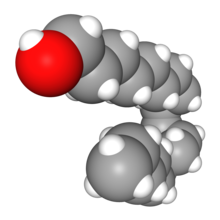
| |

| |
| Names | |
|---|---|
| IUPAC name (Z)-Octadec-9-en-1-ol | |
| Other names cis-9-Octadecen-1-ol | |
| Identifiers | |
| CAS Number | |
| 3D model (JSmol) | |
| ChEBI | |
| ChemSpider | |
| ECHA InfoCard | 100.005.089 |
| KEGG | |
| PubChem CID | |
| UNII | |
| CompTox Dashboard (EPA) | |
InChI
| |
SMILES
| |
| Properties | |
| Chemical formula | C18H36O |
| Molar mass | 268.485 g·mol |
| Density | 0.845-0.855 g/cm |
| Melting point | 13 to 19 °C (55 to 66 °F; 286 to 292 K) |
| Boiling point | 330 to 360 °C (626 to 680 °F; 603 to 633 K) |
| Solubility in water | Insoluble |
| Hazards | |
| NFPA 704 (fire diamond) |
 |
| Except where otherwise noted, data are given for materials in their standard state (at 25 °C , 100 kPa).
| |
Oleyl alcohol /ˈoʊliˌɪl, ˈoʊliəl/, or cis-9-octadecen-1-ol, is an unsaturated fatty alcohol with the molecular formula C18H36O or the condensed structural formula CH3(CH2)7−CH=CH−(CH2)8OH. It is a colorless oil, mainly used in cosmetics.
It can be produced by the hydrogenation of oleic acid esters by Bouveault–Blanc reduction, which avoids reduction of the C=C group (as would occur with usual catalytic hydrogenation). The required oleate esters are obtained from beef fat, fish oil, and, in particular, olive oil (from which it gains its name). The original procedure was reported by Louis Bouveault in 1904 and subsequently refined.
It has uses as a nonionic surfactant, emulsifier, emollient and thickener in skin creams, lotions and many other cosmetic products including shampoos and hair conditioners. It has also been investigated as a carrier for delivering medications through the skin or mucous membranes; particularly the lungs.
See also
- Oleic acid - the corresponding fatty acid
- Oleylamine - the corresponding amine
- Oleamide - the corresponding amide
References
- "Oleyl" in the McGraw–Hill Dictionary of Scientific & Technical Terms (2003)
- Noweck, Klaus; Grafahrend, Wolfgang (2006). "Fatty Alcohols". Ullmann's Encyclopedia of Industrial Chemistry. Weinheim: Wiley-VCH. doi:10.1002/14356007.a10_277.pub2. ISBN 978-3527306732.
- Bouveault, L.; Blanc, G. (1904). "Hydrogénation des éthers des acides possédant en outre les fonctions éther-oxyde ou acétal" [Hydrogenation of the ether of the acids furthermore possessing the ether-oxide or acetal functions]. Bull. Soc. Chim. Fr. (in French). 31 (3): 1210–1213.
- Reid, E. E.; Cockerille, F. O.; Meyer, J. D.; Cox, W. M.; Ruhoff, J. R. (1935). "Oleyl Alcohol". Organic Syntheses. 15: 51. doi:10.15227/orgsyn.015.0051; Collected Volumes, vol. 2, p. 468.
- Adkins, Homer; Gillespie, R. H. (1935). "Oleyl alcohol". Org. Synth. 29: 51. doi:10.15227/orgsyn.015.0051.
- Hussain, Alamdar; Arnold, John J.; Khan, Mansoor A.; Ahsan, Fakhrul (2004). "Absorption enhancers in pulmonary protein delivery". J. Control. Release. 94 (1): 15–24. doi:10.1016/j.jconrel.2003.10.001. PMID 14684268.